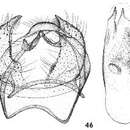fi
nimet breadcrumb-navigoinnissa


Ectoedemia heckfordi is a moth of the family Nepticulidae. It is only known from Devon in Great Britain, having been discovered in 2004 at the National Trust's Hembury Woods by amateur naturalist Bob Heckford, for whom it is named.[1]
The wingspan is 4.8–6.2 mm. Adults are on wing from April to May. There is one generation per year.
The bright green larvae feed on oaks, Quercus petraea and Quercus robur. They mine the leaves of their host plant.[1] The mine consists of a short, highly contorted gallery, occupying a small space only, filled with black frass, later broken. The mine suddenly enlarges into an elongated blotch, with frass concentrated in two lines along the edges. The mines usually occur on saplings, seedlings or low growth and in shade.[1]
In April 2010, Heckford presented the type specimen to the Natural History Museum in London.[1]
Ectoedemia heckfordi is a moth of the family Nepticulidae. It is only known from Devon in Great Britain, having been discovered in 2004 at the National Trust's Hembury Woods by amateur naturalist Bob Heckford, for whom it is named.
The wingspan is 4.8–6.2 mm. Adults are on wing from April to May. There is one generation per year.
The bright green larvae feed on oaks, Quercus petraea and Quercus robur. They mine the leaves of their host plant. The mine consists of a short, highly contorted gallery, occupying a small space only, filled with black frass, later broken. The mine suddenly enlarges into an elongated blotch, with frass concentrated in two lines along the edges. The mines usually occur on saplings, seedlings or low growth and in shade.
In April 2010, Heckford presented the type specimen to the Natural History Museum in London.

Male genitalia

Male genitalia

Female genitalia

Female genitalia

Female terminal abdominal segment

Final instar larva on Quercus petraea

Leafmine
Ectoedemia heckfordi is een vlinder uit de familie dwergmineermotten (Nepticulidae). De wetenschappelijke naam is voor het eerst geldig gepubliceerd in 2010 door van Nieukerken, A. & Z. Lastuvka.
De soort komt voor in Europa.
Bronnen, noten en/of referentiesEctoedemia heckfordi là một loài bướm đêm thuộc họ Nepticulidae. Nó là loài duy nhất được tìm thấy ở Devon in Đảo Anh, having been discovered năm 2004[1] at the National Trust's Hembury Woods[1] by amateur naturalist Bob Heckford, for whom it is named[1].
Sải cánh dài 4.8-6.2 mm. Con trưởng thành bay từ tháng 4 đến tháng 5. Có một lứa một năm.
The bright green[1] larvae feed on cây sồis, Quercus petraea và Quercus robur. Chúng ăn lá nơi chúng làm tổ[1]. In tháng 4 năm 2010, Heckford presented the type specimen to the Natural History Museum in London[1].
Ectoedemia heckfordi là một loài bướm đêm thuộc họ Nepticulidae. Nó là loài duy nhất được tìm thấy ở Devon in Đảo Anh, having been discovered năm 2004 at the National Trust's Hembury Woods by amateur naturalist Bob Heckford, for whom it is named.
Sải cánh dài 4.8-6.2 mm. Con trưởng thành bay từ tháng 4 đến tháng 5. Có một lứa một năm.
The bright green larvae feed on cây sồis, Quercus petraea và Quercus robur. Chúng ăn lá nơi chúng làm tổ. In tháng 4 năm 2010, Heckford presented the type specimen to the Natural History Museum in London.
Male genitalia
Male genitalia
Female genitalia
Female genitalia
Female terminal abdominal segment
Final instar larva on Quercus petraea
Leafmine